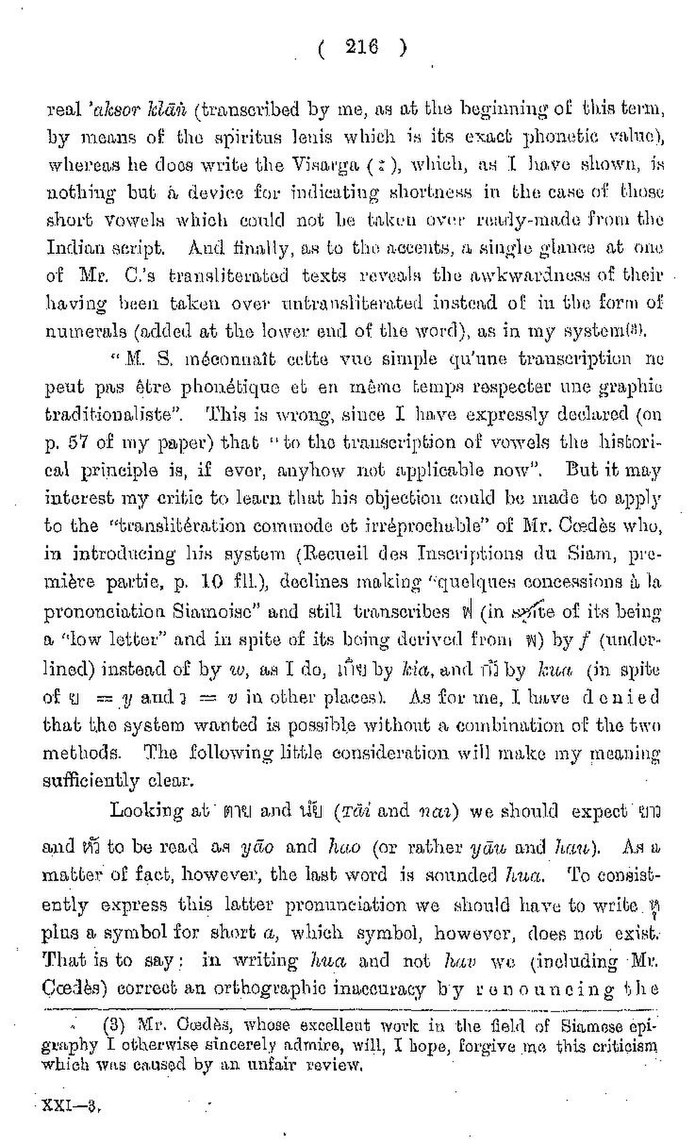( 216 )
real 'alksor klāṅ (transcribed by me, as at the beginning of this term, by means of the spiritus lenis which is its exact phonetic value), whereas he does write the Visarga ((![]() Indic characters)), which, as I have shown, is nothing but a device for indicating shortness in the case of those short vowels which could not be taken over ready-made from the Indian script. And finally, as to the accents, a single glance at ono of Mr. C.'s transliterated texts reveals the awkwardness of their having been taken over untransliterated instead of in the form of numerals (added at the lower end of the word), as in my system[1].
Indic characters)), which, as I have shown, is nothing but a device for indicating shortness in the case of those short vowels which could not be taken over ready-made from the Indian script. And finally, as to the accents, a single glance at ono of Mr. C.'s transliterated texts reveals the awkwardness of their having been taken over untransliterated instead of in the form of numerals (added at the lower end of the word), as in my system[1].
"M. S. méconnaît cette vue smnple qu'une transcription ne peut pas être phonétique et en même temps respecter une graphie traditionaliste". This is wrong, siune I have expressly declared (on p. 57 of my paper) that "to the transcription of vowels the historical principle is, if ever, anyhow not applicable now". But it may interest my critic to learn that his objection could be made to apply to the "translitération commode et irréprochable" of Mr. Coedès who, in introducing his system (Recueil des Inscriptions du Siam, première partie, p. 10 fll.), declines making "quelques concessions à la prononciation Siamoise" and still transeribes (![]() Indic characters) (in spite of its being a "low letter" and in spite of its being derived from (
Indic characters) (in spite of its being a "low letter" and in spite of its being derived from (![]() Indic characters)) by f (underlined) instead of by w, as I do, (
Indic characters)) by f (underlined) instead of by w, as I do, (![]() Indic characters) by kia, and (
Indic characters) by kia, and (![]() Indic characters) by kua (in spite of (
Indic characters) by kua (in spite of (![]() Indic characters) = y and (
Indic characters) = y and (![]() Indic characters) = v in other places). As for me, I have denied that the system wanted is possible without a combination of the two methods. The following little consideration will make my meaning sufficiently clear.
Indic characters) = v in other places). As for me, I have denied that the system wanted is possible without a combination of the two methods. The following little consideration will make my meaning sufficiently clear.
Looking at (![]() Indic characters) and (
Indic characters) and (![]() Indic characters) (Tāi and nai) we should expect (
Indic characters) (Tāi and nai) we should expect (![]() Indic characters) and (
Indic characters) and (![]() Indic characters) to be read as yāo and hao (or rather yāu and hau). As a matter of fact, however, the last word is sounded hua. To consistently express this latter pronunciation we should have to write (
Indic characters) to be read as yāo and hao (or rather yāu and hau). As a matter of fact, however, the last word is sounded hua. To consistently express this latter pronunciation we should have to write (![]() Indic characters) plus a symbol for short a, which symbol, however, does not exist. That is to say: in writing hua and not hav we (including Mr. Coedès) correct an orthographic inaccuracy by renouncing the
Indic characters) plus a symbol for short a, which symbol, however, does not exist. That is to say: in writing hua and not hav we (including Mr. Coedès) correct an orthographic inaccuracy by renouncing the
- ↑ Mr. Coedès, whose excellent work in the field of Siamese epigraphy I otherwise sincerely admire, will, I hope, forgive me this criticism which was caused by an unfair review.
